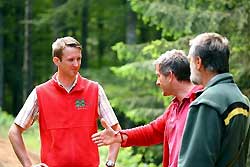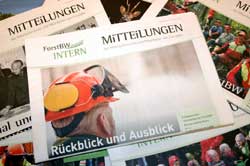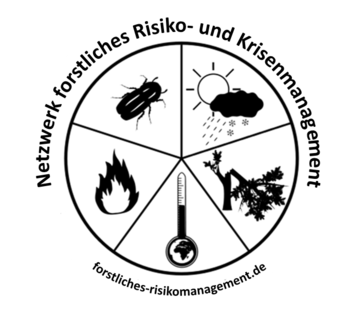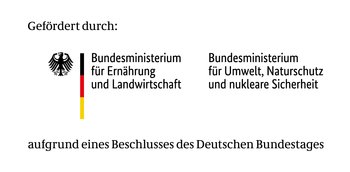It’s not good if the local forest ranger learns what the forest office’s post storm remediation strategy will look like from the press. This can only happen if the enterprise or authority management give information to the media without informing their own workers about the current state of play.
The foundation for effective communication in a crisis is established well before a crisis. The trust and bond between the employees and the employer as well as a functioning communication structure play a decisive role.
An employee’s trust in their employer has to be built and maintained over time. Loyalty and hence their willingness to support their employer – even in a crisis - grows with this trust. Staff communication is an ongoing process. The means and mediums to be used must already be familiar to staff if they are to be utilised in a crisis.
Employees are disseminators

Fig. 1: Communication is especially important in times of crisis. Photo: Forest Image Database B-W
One’s own employees are disseminators who express their opinions and share knowledge outside of work. On being asked, they provide information about events or factual advice to their circle of acquaintances. Particularly as “the forester” one is frequently asked about all sorts of forestry issues. Therefore there is nothing worse than when an employee is not directly informed about important events but instead learn about them from the media, or when a conversation partner has more up-to-date news about a certain topic.
Employees form an independent, homogenous, crisis communication target group. One’s own personnel must receive the same information in a crisis situation as external target audiences. One should pass on this information to employees before or at least at the same time as it’s published in the media. As a basic principle, all press releases should be given to internal distributers (district/field office). Internal and external communication and personnel are therefore interconnected. Well before a crisis the means of communicating in a crisis must be determined and procedures practised.
How do I tell my staff?

Fig. 2: Staff newspapers – one way to communicate. Photo: FVA/Kaulfuß
As for other target groups, a department or enterprise is faced with the question of : With which means of communication can I reach my employees? What information is important?
In the forest sector, along with office workers, many employees operate in the field. In addition there are issues of geographic distribution and different organisational affiliations. Unlike a large factory which has one production location, foresters and lumberjacks work scattered across a large expanse. Therefore handouts or an announcement on a blackboard are not included as a possible communication tool. Nonetheless, there remains a multitude of options to ensure that information still reaches everyone. The most important tools are presented in Table 1.
| Tab. 1: The most important internal communication tools. | ||
| Tool | What | Advantage (+) Disadvantage (-) |
| Circulars letter, fax | Important information is sent to employees. Depending on the technology state - per email or fax. Circulars are also an option. | - only reaches employees with email or fax (e.g. no lumberjacks) - flood of information use sparingly + information can be saved and reread |
| Intranet | Information to pick up yourself i.e. information is made available and can be read if interested. Information is kept current. | - only for employees with access to the intranet - has to be constantly updated + information as required |
| Information event | Either for all workers together or for different levels. Possible to share information. Well structured so that there is no senseless "waffle". | + all employees can be reached |
| Meetings | Regular team meetings at all levels. At short intervals in the beginning. Possible to exchange information. Well structured so that there is no senseless "waffle". | + direct exchange between employees - too many and too long meetings are "annoying" |
| Staff newsletter | If already established, a well known information medium, extensive background information possible, common questions can be centrally answered. | + all employees can be reached - currentness in the digital age |
| Talks | Personal conversations between management and employees, onsite presence, communicate background and strategies, one-on-one or group chats | + direct line to employees - time consuming |
| Crisis telephone | Central contact point for important questions, or helpline for affected workers | - greater organisation effort + dialog is possible + direct line |
| Informal gatherings | Regular sharing of information by all in a relaxed atmosphere (employees, businesses, private forest owners) | +organisationally comprehensive + everyone can, but doesn’t have to, participate |
In forestry a mix of mediums is needed. Not all employees work at a PC and have the possibility of using electronic media. Therefore information must flow through various channels.
If a business or authority has an intranet, then they can do away with long winded emails. Employees receive a short email with only the essential information as well as directions to an intranet or internet page which contains the most current and comprehensive information and tips on dealing with the crisis. Each employee can decided for themselves if they want to refer to the information provided and go into the issue in more detail. A special issue of a staff newspaper which is published shortly after the event can also be used to reach colleagues who don’t have access to information on the intranet.
Probably the most important method in the forest sector is personal contact. Employees receive first hand information from meetings, information events or personal conversations. An additional positive effect of direct contact is that it provides an opportunity for dialog. Employees have the change to give feedback to the authority/enterprise management or they can submit their own proposals to solve current problems.
While dealing with a crisis regular meetings at all levels are indispensible. At the beginning or a crisis they should be held at short intervals. This ensures the information flow and that colleagues have the opportunity to discuss the problem between themselves and work together on strategies to resolve it. Structure these events so that you don’t start “waffling” in the meeting.
At the beginning or even before the start of an expected large calamity e.g. a hurricane, a date for a staff meeting can be set and advertised. The date should be set so that the first situation report will have already taken place and management will have decided the basic response strategy. In the ensuing hectic this fixed date gives employees a reference point amidst the chaos they are experiencing.
For long lasting crises, introduce regular appointments (fixed dates) in which all contractors and those with organisational responsibility for the enterprise (foresters/foremen/machinery operations manager) participate and agree things together.
Informal gatherings have proven to be useful as a platform to exchange information – especially when processing storm damaged timber. Every one to two weeks everyone involved in the processing work - the employees, engaged contractors, private forest owners etc. – get together. Experiences and information can be shared in a relaxed atmosphere
What do I tell my employees?
Openness, honesty and integrity are, along with consistency, the most important characteristics of internal communication. Employees have their own view of things and draw their own conclusions. Half-truths and attempts at evasion only feed the rumour mill and jeopardise employees’ trust.
Material communicated at the management level deals on one hand with the crisis event itself and on the other with how it will be dealt with. At the beginning of the crisis questions more related to the event are the reporting focus. What has happened? Who has been affected? But together with these pure facts, one must also show how this crisis will be tackled. What are we doing? This subject is followed by practical advice about what everyone can do to overcome the crisis. Who can help me with this problem? What can I do? Where can I find information? Over time these issues change. A forward looking perspective and positive, motivating reports are important. Acknowledge efforts which have already been made during this phase. What have we achieved? What’s the next step?
As with many situations internal communication depends on good preparation. The information pathways in the office/business must be known. Who can I quickly reach through which mediums? Which mediums do employees use? These questions must be asked well before the event and then preparations can be made. If every task and process is known, then a crisis becomes more manageable and easier to overcome.
Literature
- Klöfer, F.; Nies, U. (2003): Erfolgreich durch interne Kommunikation: Mitarbeiter besser informieren, motivieren und aktivieren. 3. vollst. überarb. und erw. Auflage.
- Nies, U. (2003): Krisenkommunikation – oft auf einem Auge blind. Beispiel: BASF baut als Botschafter auf Mitarbeiter im Umfeld. In: Klöfer, F.; Nies, U. (2003): Erfolgreich durch interne Kommunikation: Mitarbeiter besser informieren, motivieren und aktivieren. 3. vollst. überarb. und erw. Auflage.
- Nolting, T.; Thießen, A. (2008): Krisenmanagement in der Mediengesellschaft – Potentiale und Perspektiven der Krisenkommunikation.
- Rieken, M. (2008): Zwölf Faktoren erfolgreicher Medienarbeit in Krisensituationen. In: Nolting, T.; Thießen, A. (2008): Krisenmanagement in der Mediengesellschaft – Potentiale und Perspektiven der Krisenkommunikation.
- Odenthal-Kahabka, J. (2005): Handbuch Sturm – Eine Arbeitshilfe für die Sturmschadensbewältigung. www.waldwissen.net
Forest Crises Management Advisory Guide
Back to the main page of the Forestry Crisis Management Advisor Guide: Overview of the different topic collections
Back to the article overview in the: Crisis Management Topic Collection



![[Translate to English:] [Translate to English:]](/assets/_processed_/5/a/csm_fva_krisenkommunikation_kk2_abb3_bdfae440db.jpeg)
![[Translate to English:] [Translate to English:]](/assets/lernen/oeffentlichkeit/fva_krisenkommunikation_kk1/fva_krisenkommunikation_kk1_sturmwurf.jpeg)
![[Translate to English:] [Translate to English:]](/assets/_processed_/a/8/csm_fva_szenariotechnik_ak1_1_711ca2f140.gif)
![[Translate to English:] [Translate to English:]](/assets/_processed_/1/d/csm_fva_krisenkommunikation_kk3_abb2_49487409aa.jpeg)
![[Translate to English:] [Translate to English:]](/assets/lernen/oeffentlichkeit/fva_sturmhandbuch_oeffentlichkeitsarbeit/fva_sturmhandbuch_oeffentlichkeitsarbeit_1.jpeg)